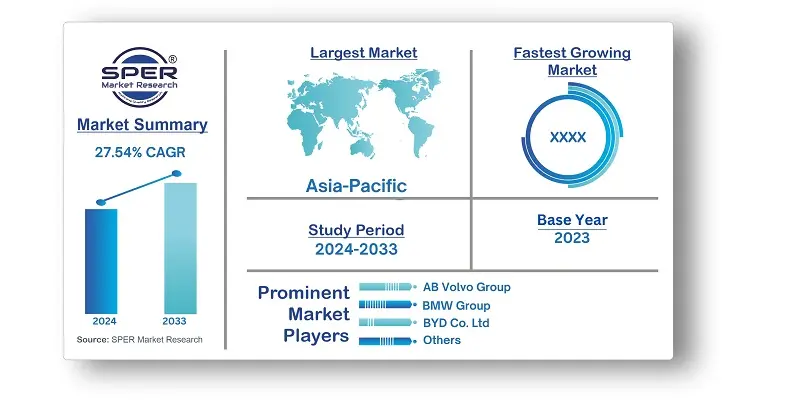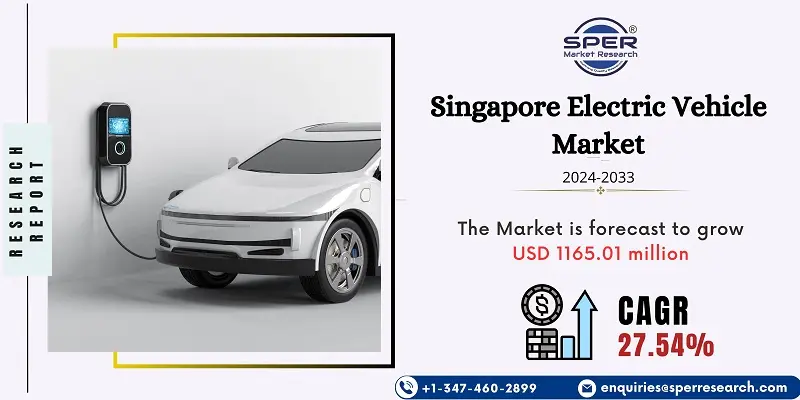
Singapore Electric Vehicle Market Trends, Share, Size, Revenue, Competition and Future Outlook
Singapore Electric Vehicle (EV) Market Growth, Size, Trends Analysis- By Vehicle Type, By Drive Train Technology, By Vehicle Class, By Top Speed, By Vehicle Drive Type- Regional Outlook, Competitive Strategies and Segment Forecast to 2033
| Published: Oct-2024 | Report ID: AMIN24223 | Pages: 1 - 108 | Formats*: |
| Category : Automotive & Transportation | |||
- November 2022: BYD Co. Ltd introduce Singapore’s first Blade Battery powered bus, B12A03.
- November 2022: Volvo Buses Singapore, part of the Volvo Group launched Volvo BZL-SC Neustar City Electric Bus, delivering the first fully electric, 3-door stepless bus that is designed, engineered, and manufactured in Singapore.
- September 2033: AB Volvo launched the C40 Recharge in Singapore. The Volvo C40 has a battery capacity of 78kWh that gives an electric driving range of up to 450km on a single charge.
- July 2022: BYD Co. Ltd launched BYD Yuan Plus under Atto 3 name in Singapore. The vehicle model has a battery capacity of 49.92 kWh and a range of up to 430 Km on a Single Charge.


| Report Metric | Details |
| Market size available for years | 2020-2033 |
| Base year considered | 2023 |
| Forecast period | 2024-2033 |
| Segments covered | By Vehicle Type, By Drive Train Technology, By Vehicle Class, By Top Speed Type, By Vehicle Drive Type |
| Regions covered | Northern, Western, Eastern and Southern. |
| Companies Covered | Audi AG; AB Volvo Group; BMW Group; BYD Co. Ltd; Hyundai Motor; Mercedes-Benz Group AG; Mitsubishi Motor Corporation; MG Motor; Nissan Motor Company; Tesla Inc, Toyota Motor Corporation. |
- Environmental Enthusiasts
- Cost- Conscious
- Incentive Seekers
- Short Commuters
- Low Maintenance Advocates
| By Vehicle Type: | |
| By Drive Train Technology: | |
| By Vehicle Class: | |
| By Top Speed: | |
| By Vehicle Drive Type: |
- Singapore Electric Vehicle Market Size (FY’2024-FY’2033)
- Overview of Singapore Electric Vehicle Market
- Segmentation of Singapore Electric Vehicle Market By Vehicle Type (Passenger Cars, Commercial Vehicles and Two Wheeler)
- Segmentation of Singapore Electric Vehicle Market By Drive Train Technology (Battery Electric Vehicle, Plug-in Hybrid Vehicles and Fuel Cell Electric Vehicles)
- Segmentation of Singapore Electric Vehicle Market By Vehicle Class (Mid Price and Luxury)
- Segmentation of Singapore Electric Vehicle Market By Top Speed (Less than 100 MPH, 100 to 125 MPH and More than 125 MPH)
- Segmentation of Singapore Electric Vehicle Market By Vehicle Drive Type (Front Wheel Drive, Rear Wheel Drive and All Wheel Drive)
- Statistical Snap of Singapore Electric Vehicle Market
- Expansion Analysis of Singapore Electric Vehicle Market
- Problems and Obstacles in Singapore Electric Vehicle Market
- Competitive Landscape in the Singapore Electric Vehicle Market
- Impact of COVID-19 and Demonetization on Singapore Electric Vehicle Market
- Details on Current Investment in Singapore Electric Vehicle Market
- Competitive Analysis of Singapore Electric Vehicle Market
- Prominent Players in the Singapore Electric Vehicle Market
- SWOT Analysis of Singapore Electric Vehicle Market
- Singapore Electric Vehicle Market Future Outlook and Projections (FY’2024-FY’2033)
- Recommendations from Analyst
1.1. Scope of the report1.2. Market segment analysis
2.1. Research data source
2.1.1. Secondary Data2.1.2. Primary Data2.1.3. SPER’s internal database2.1.4. Premium insight from KOL’s
2.2. Market size estimation
2.2.1. Top-down and Bottom-up approach
2.3. Data triangulation
4.1. Driver, Restraint, Opportunity and Challenges analysis
4.1.1. Drivers4.1.2. Restraints4.1.3. Opportunities4.1.4. Challenges
4.2. COVID-19 Impacts of the Singapore Electric Vehicles (EV) Market
5.1. SWOT Analysis
5.1.1. Strengths5.1.2. Weaknesses5.1.3. Opportunities5.1.4. Threats
5.2. PESTEL Analysis
5.2.1. Political Landscape5.2.2. Economic Landscape5.2.3. Social Landscape5.2.4. Technological Landscape5.2.5. Environmental Landscape5.2.6. Legal Landscape
5.3. PORTER’s Five Forces
5.3.1. Bargaining power of suppliers5.3.2. Bargaining power of buyers5.3.3. Threat of Substitute5.3.4. Threat of new entrant5.3.5. Competitive rivalry
5.4. Heat Map Analysis
6.1. Singapore Electric Vehicles Market Manufacturing Base Distribution, Sales Area, Product Type6.2. Mergers & Acquisitions, Partnerships, Product Launch, and Collaboration in Singapore Electric Vehicles Market
7.1. Singapore Electric Vehicles Market Size, Share and Forecast, By Vehicle Type, 2020-20267.2. Singapore Electric Vehicles Market Size, Share and Forecast, By Vehicle Type, 2027-20337.3. Passenger Cars7.4. Commercial Vehicles7.5. Two-Wheeler
8.1. Singapore Electric Vehicles Market Size, Share and Forecast, By Drive Train Technology, 2020-20268.2. Singapore Electric Vehicles Market Size, Share and Forecast, By Drive Train Technology, 2027-20338.3. Battery Electric Vehicles8.4. Plug-in Hybrid Electric Vehicles8.5. Fuel Cell Electric Vehicles
9.1. Singapore Electric Vehicles Market Size, Share and Forecast, By Vehicle Class, 2020-20269.2. Singapore Electric Vehicles Market Size, Share and Forecast, By Vehicle Class, 2027-20339.3. Mid-Price9.4. Luxury
10.1. Singapore Electric Vehicles Market Size, Share and Forecast, By Top Speed, 2020-202610.2. Singapore Electric Vehicles Market Size, Share and Forecast, By Top Speed, 2027-203310.3. Less Than 100 MPH10.4. 100 to 125 MPH10.5. More than 125 MPH
11.1. Singapore Electric Vehicles Market Size, Share and Forecast, By Vehicle Drive Type, 2020-202611.2. Singapore Electric Vehicles Market Size, Share and Forecast, By Vehicle Drive Type, 2027-203311.3. Front Wheel Drive11.4. Rear Wheel Drive11.5. All Wheel Drive
12.1. Singapore Electric Vehicles Market Size and Market Share
13.1. Singapore Electric Vehicles Market Size and Market Share By Region (2020-2026)13.2. Singapore Electric Vehicles Market Size and Market Share By Region (2027-2033)13.3. Northern Region13.4. Southern Region13.5. Eastern Region13.6. Western Region
14.1. Audi AG
14.1.1. Company details14.1.2. Financial outlook14.1.3. Product summary14.1.4. Recent developments
14.2. AB Volvo Group
14.2.1. Company details14.2.2. Financial outlook14.2.3. Product summary14.2.4. Recent developments
14.3. BMW Group
14.3.1. Company details14.3.2. Financial outlook14.3.3. Product summary14.3.4. Recent developments
14.4. BYD Co. Ltd
14.4.1. Company details14.4.2. Financial outlook14.4.3. Product summary14.4.4. Recent developments
14.5. Hyundai Motor
14.5.1. Company details14.5.2. Financial outlook14.5.3. Product summary14.5.4. Recent developments
14.6. Mercedes-Benz Group AG
14.6.1. Company details14.6.2. Financial outlook14.6.3. Product summary14.6.4. Recent developments
14.7. Mitsubishi Motor Corporation
14.7.1. Company details14.7.2. Financial outlook14.7.3. Product summary14.7.4. Recent developments
14.8. MG Motor
14.8.1. Company details14.8.2. Financial outlook14.8.3. Product summary14.8.4. Recent developments
14.9. Nissan Motor Company
14.9.1. Company details14.9.2. Financial outlook14.9.3. Product summary14.9.4. Recent developments
14.10. Tesla Inc
14.10.1. Company details14.10.2. Financial outlook14.10.3. Product summary14.10.4. Recent developments
14.11. Toyota Motor Corporation
14.11.1. Company details14.11.2. Financial outlook14.11.3. Product summary14.11.4. Recent developments
14.12. Others
SPER Market Research’s methodology uses great emphasis on primary research to ensure that the market intelligence insights are up to date, reliable and accurate. Primary interviews are done with players involved in each phase of a supply chain to analyze the market forecasting. The secondary research method is used to help you fully understand how the future markets and the spending patterns look likes.
The report is based on in-depth qualitative and quantitative analysis of the Product Market. The quantitative analysis involves the application of various projection and sampling techniques. The qualitative analysis involves primary interviews, surveys, and vendor briefings. The data gathered as a result of these processes are validated through experts opinion. Our research methodology entails an ideal mixture of primary and secondary initiatives.



Frequently Asked Questions About This Report
PLACE AN ORDER
Year End Discount
Sample Report
Pre-Purchase Inquiry
NEED CUSTOMIZATION?
Request CustomizationCALL OR EMAIL US
100% Secure Payment






Related Reports
Our Global Clients
Our data-driven insights have influenced the strategy of 200+ reputed companies across the globe.




















